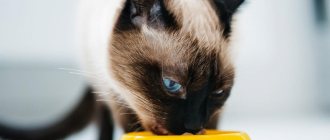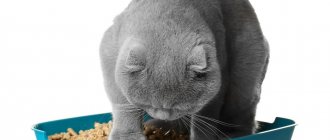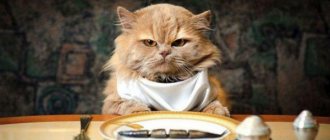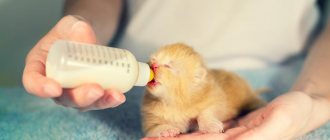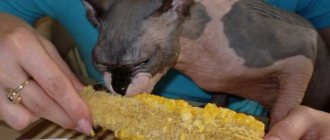Proper nutrition for a kitten is the key to its future health. Unfortunately, the owner cannot provide the baby with the food that his relatives ate in the wild. If you start feeding him food bought in a store and intended for people, then rarely does anyone manage to avoid stomach upset in a small pet. Only special food for kittens of good quality guarantees the absence of such troubles.
Why do you need food for kittens?
A small kitten requires an increased amount of proteins, vitamins, and microelements compared to adult animals. Calcium and phosphorus are needed for the construction of bones and teeth, vitamins for the development of vision. Since mothers feed their babies mainly until two months, and after that the owner must deal with this issue, he should have a good idea of what kind of nutrition a small growing organism needs so that it can turn into a healthy, cheerful animal. After two months, kittens begin to be interested in what their mother cat eats. Which food to choose for a kitten? The veterinarian's advice to the owner leaves the choice between homemade food or factory-produced food (dry and wet).
How to satisfy a kitten's needs?
Still, it cannot be denied that a growing body requires more nutrients and calories than adult cats, and therefore feeding standards for them are higher than for adults. Thus, the daily intake of Orijen Cat&Kitten food for a kitten aged 5 to 20 weeks is 60 g per kg of weight - for comparison, this is almost the same as what a five-kilogram adult cat requires.
By increasing the amount of food, we simultaneously increase the intake of calories, as well as all other substances necessary for the kitten - vitamins, microelements, fiber, etc. So there is no need to be afraid that the baby will lack something - if the nutrition meets his physiological needs as a biological species, then he will grow up healthy and strong.
Natural food or prepared food?
If there is no meat in your pet’s diet, then he begins to have problems with cell regeneration, blood clotting, and other diseases. Sugar, starch, and smoked foods are contraindicated for cats.
However, you cannot feed cats only meat, as they develop a lack of calcium in their bodies with an excess of phosphorus. Thyroid disease begins, reducing skeletal mineralization. The gait is disturbed, the hind legs fail, and loving owners run to the veterinarian because they believe that the pet jumped off from above and injured itself. In addition to meat, a cat also needs offal and plant foods.
In nature, cats obtain plant food by eating the contents of the stomachs of captured small animals. Such plants are already in a semi-digested state, ideally accepted by the digestive system of carnivores.
Porridge, fish, dairy products, and sausages are not suitable food for cats, as they provoke a concentration of urine in the body, and this, in turn, causes urolithiasis. Mineral salts from undigested foods appear as crystalline urine sediments.
So, if you feed your beloved pets the right homemade food, then creating a diet turns out to be quite a difficult task. Veterinarians are constantly asked whether it is possible to feed a kitten adult food. The best food in nature would be the little mice that the mother provided for kittens, but since there are no such mice in city apartments, the person himself must provide his pets with everything necessary for growth and proper development.
Fortunately, manufacturers have taken care of the proper nutrition of animals, producing dry and wet food for them and their babies, which contain well-balanced nutrients necessary for health.
Beginning of training
In normal mode, the mother herself gradually minimizes feeding of the offspring.
When 3–4 weeks have passed since his birth, the cat begins to avoid kittens, and her milk production decreases. And the kittens no longer get enough nutrition from their mother. In search of an additional source of energy, they begin to try new foods. During this period, it is advisable to offer them food suitable for the first feeding. This includes, in particular, specialized diets for kittens Royal Canin Mother&Babycat, Royal Canin Kitten, and the Whiskas brand line. Also, the corresponding feeds are produced under the brands Acana, Wellkiss, Purina Pro Plan, Bosch and others.
Experts recommend combining dry and wet diets from the first days of switching to a new food.
But if wet food does not need preliminary preparation, then dry food can be diluted with water at first until it becomes a paste. Then the amount of water should be gradually reduced so that the kitten painlessly gets used to the new texture of the food.
Dry or wet food?
There are two types of wet food:
- pouches (“bags”) - contain quite a lot of moisture in the form of broth or sauce with pieces of food;
- canned food - packaged in metal jars of various sizes, designed for longer storage than pouches.
Dry cereals are a perfectly balanced diet for adults and children and contain a small amount of water (5-12%). They are economical, can be stored for a long time, and preserve their taste. Cats can feel great all their lives eating only dry rounds. It is always written on the packaging for owners at what age kittens can eat dry food.
The only condition! A cat eating “crackers” should always have access to a bowl filled with clean drinking water for washing down. Whether it is possible to feed a kitten with adult food is up to the owner to decide, but it is better not to do this for at least 6 months.
Kittens can be given dry food from 2-3 months. But kids should not buy economy-class products. It is better to start with premium products, the composition of which is best balanced for the correct diet of kittens.
Can kittens eat adult food: what is more beneficial?
Most breeders are interested in the question of how to choose the right food for their pet. Most veterinarians recommend feeding your pets both natural food and special food. Giving food “from the table” is not recommended, since human food contains much less protein than cat food. For this reason, in order to make your pet’s diet as suitable as possible, you need to know how much nutrients your kitten should consume.
According to the recommendations, it is not recommended to give young kittens adult food until they are 6 months old. As for dry food, it is allowed to be included in the diet from 2-3 months. Also note that you need to start with premium food, they are much better suited for animals, because they are more balanced for their health.
How many times a day should you feed your kitten?
From the age of one month, a kitten should begin to be taught to feed itself. He is transferred to dry and wet ready-made food within a month. It is better to give food to the baby often, but little by little. As the famous advertisement says: a kitten's stomach is smaller than a thimble. When eating dry food, the baby does not know when to stop. If he gets too full, there is a high chance of vomiting.
- When the baby is 1.5-2 months old, he needs to be given food at least 6 times a day, trying to do it at the same time.
- At the age of 4 months, you can already decide how many times a day to feed the kitten - 3 or 4. At the same time, you can leave dry granules constantly in the bowl if the owner is busy throughout the day.
- From 10 months the kitten is considered an adult.
- By the age of one year, the transition to adult nutrition is completely completed.
Main differences between feeds
Of course, natural feeding is best for kittens. First, this is mother's milk, then from a month you can give baby formula or powdered milk diluted with water. Well, later they gradually switch to porridge, vegetables, boiled meat, cottage cheese.
We recommend this article:
How to properly create a diet and feed a kitten
Cats under one year of age are considered kittens. You should take a particularly responsible approach to the nutrition of kittens under six months of age. If during this period there are malfunctions in the gastrointestinal tract, they will make themselves felt throughout life.
If owners do not want to bother with cooking, then as an option they can choose professional food for kittens. Here, of course, you should choose a high-quality diet from a reliable manufacturer. You need to choose super premium and holistic food, which contain more natural meat. Manufacturers have special lines for kittens.
Although experts do not recommend feeding kittens only dry food. The diet of babies is not very wide, but it is also not worth adding variety to it by eating food for adult animals.
We recommend this article:
What should you feed your cat at home?
The best option for little fluffies is a combination diet, including natural food and high-quality professional food for kittens (it should be given once a day).
When old and young eat the same food, this can lead to unpleasant consequences. Some furry owners are perplexed about the difference between dry food for kittens and adult food.
Adult cats eat less often, but in larger portions, and babies eat every two hours, but little by little. A growing body needs food containing many calories. There should be enough energy for both development and games. Adults have absolutely no need for this amount of calories, so food for adults has low energy value.
Kitten food has a high carbohydrate content, which helps to gain energy.
A healthy cat sleeps approximately 80% of the time. And the animal does this in order to conserve energy, since in the wild it needs it for hunting. The kitten is sleeping because it has run around, got frisky and is tired. Therefore, an adult murka does not need additional carbohydrates. And if they regularly enter her body in large quantities, she will develop obesity.
We recommend this article:
How many times a day is it recommended to feed a cat?
A cat that has caught a mouse, eating it, receives the necessary protein, and in the process of digesting it, a parallel process of protein synthesis occurs in its body. It turns out that what we need to take from the outside, the cat perfectly produces on its own.
During sleep, the body of a healthy cat produces a sufficient amount of slow carbohydrates, which serve as food for brain cells and the central nervous system.
We recommend this article:
Assortment and composition of cat food Royal Canin
Babies also undergo processes of synthesizing carbohydrates, but given their active lifestyle, not enough of them are produced. The quality of sleep also influences the process. And babies sleep restlessly, often wake up and do not fall asleep for a long time, since their nervous system is in an excited state.
Babies need their food to be enriched with a large amount of minerals and trace elements. The lack of these nutrients will inhibit the growth and development of babies. The composition of food for adults differs in the concentration of vitamins and microelements.
We recommend this article:
Description and composition of Whiskas food for kittens and adult cats
The feed also differs in the size of the granules. Babies eat small pieces, but large granules will be difficult for them to chew and may cause them to choke.
Is it possible to give a kitten food from an adult cat?
Ready-made food is an excellent choice for working people who cannot pay enough attention to preparing their cat’s diet. The transition to adult food from children's food occurs simply - during the period of life recommended by veterinarians. But it is better to buy food for your pet that costs a higher class than food from the “economy” category. Economy grade kibble contains more vegetables and bone meal than is necessary for a cat's health. The premium class fully satisfies the kittens' need for quality food.
Cat owners often ask the question: “Can I feed my kitten adult food?” Of course, if the baby eats dry granules from the mother's bowl, then nothing bad will happen. But it is better not to constantly feed products to adult animals, because they contain less vitamins, calcium, phosphorus and other substances necessary for the proper development of a growing organism.
Dry food can be wetted the first time, but as a rule this is not required. At two months, the kitten can perfectly chew food pellets with its sharp teeth.
Emergency
During the first month of life, through mother's milk, the kitten receives all the necessary substances in the correct balance. Therefore, it is critical for the formation of the animal’s immunity.
There is practically nothing to replace this food - cow's milk is not at all suitable for a kitten. For comparison: cat milk has one and a half times more protein than cow's milk, and at the same time it contains moderate amounts of fat, calcium and phosphorus.
But what if, for certain reasons, it is not available? A number of manufacturers have rations in case a cat has lost milk or the kitten has been weaned from her early - this is, for example, Royal Canin Babycat Milk. This food fully meets the needs of a newly born animal and can serve as a worthy alternative to mother's milk.
What is the difference between dry food for kittens and adult food?
Dry food is the most convenient for owners: it is stored for a long time, is easy to use, and contains the vitamins and minerals that your pet needs. The granules can be poured into an automatic feeder and you can forget about feeding for a long time. In addition, crackers do not stain dishes, the floor around the bowl, or the cat itself.
Dry food is divided into several types:
- Economy class - the cheapest in the line. Veterinarians do not recommend using such food, since it contains a minimal amount of nutrients;
- premium and super-premium - suitable for almost all animals without health problems;
- holistic – food of the highest quality, made only from natural products;
- medicinal – prescribed by a veterinarian for feeding animals with chronic diseases.
Depending on the age category, food is divided into children's and adults. The differences between them are as follows:
- size. Dry food pellets for kittens are smaller and more porous, as it is difficult for a kitten to chew through dense pieces with its baby teeth. In addition, the porous structure helps clean plaque from the kitten’s fangs. If you give this food to an adult pet, he can swallow it without chewing due to the small size of the granules. After some time, your pet will develop plaque and tartar, because his teeth are not cleaned at all during feeding;
- energy value. A kitten's growing body requires more calories than an adult animal. Therefore, kitten food is approximately 20-30% higher in calories. If you feed such food to an already grown, mature cat, it threatens obesity and digestive problems;
- protein and fat content. As the kitten grows, its skeleton, cardiovascular and nervous systems are formed, which requires a high content of animal proteins and fats. To achieve this, baby food manufacturers add more natural meat ingredients. If there is a lack of protein, the baby will be lethargic and inactive. And with a severe deficiency, problems with the heart and central nervous system are possible, which can manifest themselves in adulthood. An increased concentration of proteins and fats is not dangerous for adult cats, but only if the animal is absolutely healthy;
- vitamins and minerals. For the proper formation of the skeleton and the replacement of teeth, a kitten needs a higher content of microelements than an adult animal. Zinc strengthens the immune system and normalizes hormonal levels. Iron promotes the development of internal organs and transports oxygen to the tissues of a growing body. Magnesium helps the cardiovascular system, the load on which is quite high in adolescence. The presence of deviations in the development of internal organs is not always noticeable and does not immediately appear, so it is better not to put the kitten at risk and initially choose the right diet. Oversaturation of the body of an adult castrated animal with microelements is fraught with the formation of stones in the urinary system.
Kittens under 6 months of age are not fed dry food. To accustom kittens older than six months to pellets, they are first soaked in water or low-fat broth and kneaded. The best feeding option is to mix soaked kibble with wet food from the same brand and class.

